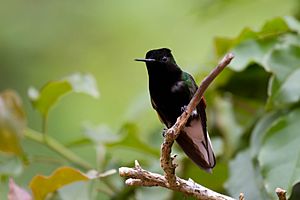Black-bellied hummingbird facts for kids
Quick facts for kids Black-bellied hummingbird |
|
|---|---|
 |
|
| Conservation status | |
| Scientific classification | |
| Genus: |
Eupherusa
|
| Species: |
nigriventris
|
 |
|
The black-bellied hummingbird (scientific name: Eupherusa nigriventris) is a tiny, colorful bird. It belongs to a group of hummingbirds called "emeralds." You can find this special bird living in the countries of Costa Rica and Panama.
Contents
About This Hummingbird Family
The black-bellied hummingbird is a "monotypic" species. This means it's the only species in its group, so there are no different subspecies or types of black-bellied hummingbirds. It is very closely related to the stripe-tailed hummingbird. Scientists call them "sister species" because they share a common ancestor.
What Does the Black-Bellied Hummingbird Look Like?
This hummingbird is quite small, usually about 7 to 8 centimeters (about 3 inches) long. It weighs around 3 to 3.5 grams, which is about the same as two paper clips!
Male vs. Female Hummingbirds
- Male black-bellied hummingbirds are easy to spot because of their black chest and belly. This is how they got their name! Their forehead and face are also black. The sides of their chest are green, and the feathers under their tail are white. Their upper body is mostly a shiny bronze-green color. Their central tail feathers are dull black, while the outer ones are white.
- Female black-bellied hummingbirds have grayish-white feathers on their underside. Their upper body is a metallic bronze-green, which is brighter on the feathers above their tail.
Both male and female hummingbirds change their feathers after breeding season. Males usually do this a month or two before the females.
Where Do Black-Bellied Hummingbirds Live?
You can find the black-bellied hummingbird mainly in Costa Rica and the western part of Panama. They mostly live on the Caribbean side of these countries.
Their Favorite Homes
These hummingbirds like to live in wet montane forests. These are forests found on mountains. They prefer the edges of these forests or even deep inside them. They usually live at heights between 600 and 2,000 meters (about 2,000 to 6,500 feet) above sea level.
How Black-Bellied Hummingbirds Behave
Do They Move Around?
Most black-bellied hummingbirds stay in the same area all year long. They are "residents." However, some of them might move to lower parts of the mountains after they have finished breeding.
What Do They Eat?
Black-bellied hummingbirds mostly drink nectar from flowers.
- Male hummingbirds often look for nectar high up in the forest canopy (the top layer of trees).
- Female hummingbirds usually find food closer to the ground or at the forest edges.
Sometimes, male hummingbirds will even protect flowering trees from other, bigger hummingbirds!
They get nectar from many different plants, including:
- Inga and Pithecellobium trees
- Plants that grow on other plants, called epiphytes, like Columnea and Elleanthus
- Understory plants like Psychotria and Besleria
They also eat small arthropods, which are tiny insects and spiders.
How Do They Raise Their Young?
In Costa Rica, the breeding season for black-bellied hummingbirds is usually from October to March. Sometimes, it can start as early as July. They often breed when many flowers are blooming, especially the epiphytes in the tree canopy.
- Nests: Female hummingbirds build a cup-shaped nest. They use scales from tree ferns and stick them together with spiderwebs. They also add moss and lichen to the outside of the nest.
- Nest Location: Nests are usually placed about 2 to 4 meters (about 6 to 13 feet) above the ground. They often build their nests under a large leaf that hangs over.
- Eggs: A female hummingbird usually lays two eggs. We don't know exactly how long it takes for the eggs to hatch or for the young birds to leave the nest.
What Sounds Do They Make?
The black-bellied hummingbird has a special song. It's described as a "high, thin, sputtering warble." They usually sing from branches at the edge of open spaces in the forest.
They also make different calls:
- A sharp, high-pitched tseep or peet sound.
- A high, tsittering sound when they are chasing each other.
Is the Black-Bellied Hummingbird in Danger?
The IUCN (International Union for Conservation of Nature) has looked at the black-bellied hummingbird. They have decided it is a species of "Least Concern." This means it is not currently in danger of disappearing.
Even though its population size is not known, and it lives in a fairly small area, no immediate threats have been found. In Costa Rica, it is considered "uncommon to locally abundant." However, it could become vulnerable if its habitat is lost.
See also
 In Spanish: Eupherusa nigriventris para niños
In Spanish: Eupherusa nigriventris para niños


